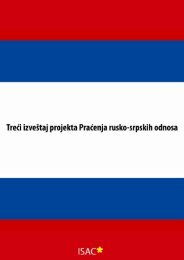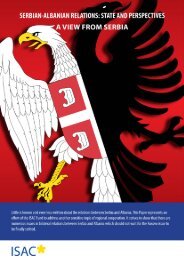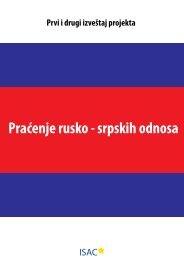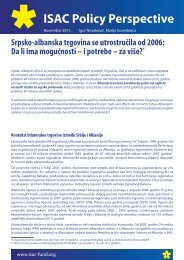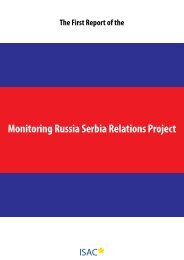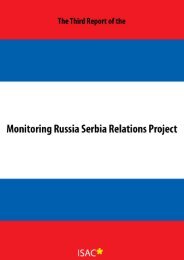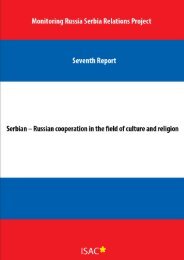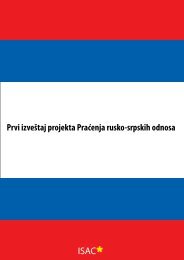the process of security sector reform - ISAC Fund
the process of security sector reform - ISAC Fund
the process of security sector reform - ISAC Fund
You also want an ePaper? Increase the reach of your titles
YUMPU automatically turns print PDFs into web optimized ePapers that Google loves.
Robert S. Tomasovic PEACE KEEPING MISSIONS<br />
Robert S. Tomasovic PEACE KEEPING MISSIONS<br />
• The UN Civilian Police Division (Department <strong>of</strong> Peacekeeping Operations)<br />
goals are to: Support <strong>the</strong> Civilian Police component <strong>of</strong> <strong>the</strong> UN<br />
peace operations, enhance planning capacity <strong>of</strong> police component <strong>of</strong> UN<br />
operations, assist in enhancing <strong>the</strong> performance, effectiveness and efficiency<br />
<strong>of</strong> local criminal justice systems, enhance <strong>the</strong> ability to deploy a<br />
functional police component rapidly, improve <strong>the</strong> quality <strong>of</strong> Civilian Police<br />
representation in <strong>the</strong> field<br />
• The European police best practice vs. traditional (classic) policing is <strong>the</strong><br />
construct under which UN Civilian Police <strong>of</strong>ficers work.<br />
• Two traditional measurements <strong>of</strong> how democratically a police force<br />
operates are: <strong>the</strong>y are responsive to <strong>the</strong> needs and desires <strong>of</strong> <strong>the</strong> public<br />
<strong>the</strong>y serve and <strong>the</strong>y are held accountable within <strong>the</strong> rule <strong>of</strong> law.<br />
Part III Civilian Actors in Peacekeeping Operations are characterized by <strong>the</strong>se<br />
points:<br />
• Civilian authorities/politicians authorize peacekeeping operations.<br />
• Host nationals must, at <strong>the</strong> end <strong>of</strong> <strong>the</strong> day, become <strong>the</strong> government <strong>of</strong> <strong>the</strong><br />
country and <strong>of</strong> its civil institutions.<br />
• The role <strong>of</strong> <strong>the</strong> International humanitarian civilian community − IGOs<br />
and NGOs are to <strong>of</strong>fer assistance, <strong>of</strong>ten first in <strong>the</strong> form <strong>of</strong> relief to help<br />
meet initial basic humanitarian needs: water, food, shelter, medical care,<br />
etc.<br />
• When <strong>the</strong> acute humanitarian effects <strong>of</strong> <strong>the</strong> conflict have been mitigated,<br />
IGO and NGO civilian organizations should transition to development<br />
assistance to help host national civilians to establish sustainable institutions:<br />
education, rule <strong>of</strong> law, civil administration − sustainable nation<br />
building.<br />
• International and national civilian agencies that help host national military<br />
personnel to transition to civilian status are essential to disarmament,<br />
demobilization, reintegration, and reconciliation (DDRR).<br />
PEACEKEEPING OPERATIONS<br />
The first peacekeeping operation, <strong>the</strong> United Nations Truce Supervision<br />
Organization (UNTSO), was established in 1948 in <strong>the</strong> Middle East and is still<br />
active today. Since that time, <strong>the</strong>re have been 56 United Nations peacekeeping<br />
operations. Since 1988 <strong>the</strong>re has been a significant increase in Peace Support<br />
Operations, 43 <strong>of</strong> <strong>the</strong> 56 have been established since 1988 with 13 still ongoing,<br />
focusing attentions on both United Nations and Multi-National missions.<br />
Peacekeeping in <strong>the</strong> beginning was a means by which <strong>the</strong> international community<br />
could encourage <strong>the</strong> establishment <strong>of</strong> sustainable peace in places and situations<br />
where conflict threatened or had been recently subdued. Initially developed as<br />
a means to resolve inter-State conflict by deploying unarmed or lightly armed<br />
military personnel from a number <strong>of</strong> countries, Peacekeepers didn’t fight fire with<br />
fire, but ra<strong>the</strong>r observed <strong>the</strong> ceasefire from <strong>the</strong> ground and reported impartially on<br />
adherence to it. Therefore for 40 + years peacekeeping was Classic or Traditional<br />
Peacekeeping.<br />
The Classic Peacekeeping period lasted from 1948 – 1988 and <strong>the</strong> 13 missions<br />
were characterized by <strong>the</strong>se eight points:<br />
• InterState conflict<br />
• Governments functioning and in control<br />
• Government infrastructure intact<br />
• Military and police structures operating<br />
• Judicial systems in place<br />
• International rules operable<br />
• Minimum contact with population<br />
• Minimum involvement with civilian agencies<br />
Following <strong>the</strong> dramatic changes in Eastern Europe in <strong>the</strong> early 1990s Peacekeeping<br />
challenges changed and can best be characterized by what we can term Nontraditional<br />
peacekeeping. It has involved implementation <strong>of</strong> complex agreements<br />
and settlements, preventive deployment’s, non-UN Peacekeeping Forces,<br />
UN forces co-deployed with regional peacekeeping Forces, <strong>the</strong> provision <strong>of</strong><br />
Humanitarian Aid, and missions involving peace enforcement. The 43 missions<br />
established since 1988 are characterized by <strong>the</strong>se 10 points:<br />
• Intra-state Conflict<br />
• Governments ineffective or not in control<br />
186 187



